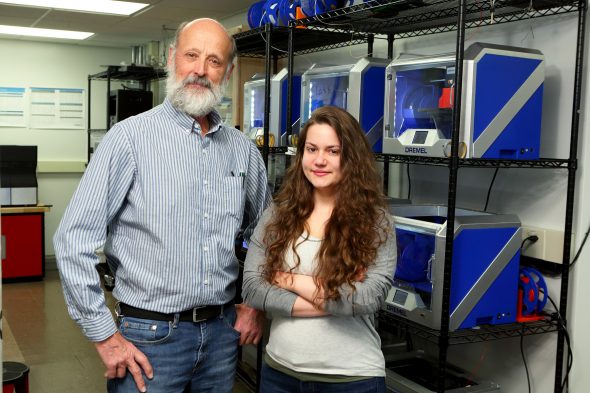East Meets West: Giving future doctors tools to design devices

Eric Schmidt and Jordan Oswald, in the College of Engineering Makerspace, taught a course for College of Medicine students on medical product design. “The students were just sponges — they really wanted to learn,” Schmidt says. (Photo: Jenny Fontaine)
A group of UIC medical students enrolled in a new course this semester had the opportunity to see how medical devices they might use in clinical practice are actually made — then create some products themselves.
A collaboration between the College of Engineering and College of Medicine gave 15 students in the Innovation in Medicine Program (IMED) the chance to visit the College of Engineering Makerspace for eight weeks to learn more about medical product design.
“Physicians trained in the process of innovating solutions to problems encountered in the clinical environment will have an understanding of how a need can be addressed and potentially translated to a commercial product solution,” said Eric Schmidt, associate director of the makerspace.
The students learned additive and subtractive manufacturing methods, including how to make parts on 3-D printers and laser cutters. They also designed 3-D boxes, name tags and race cars, among other projects.
“Making a name tag doesn’t look that difficult until you do it,” said Jordan Oswald, a graduate student in mechanical engineering who helped teach the course. “Learning CAD (computer-aided design) isn’t trivial.”
“It was great to see them way out of their comfort zone while fabricating parts on our equipment,” added Schmidt, who collaborated on the project with Miiri Kotche, clinical associate professor in bioengineering and director of the IMED Program.
“The students were just sponges — they really wanted to learn.”
The course helps bridge the gap between those who work in health care and have ideas for medical devices, and those who actually make them, Oswald said.
“It gives the students a much more grounded way to think about a real device,” she said.
Among the students in the class was John Marsiglio, a first-year medical student who joined the IMED Program last fall after completing his undergraduate and graduate studies in chemical engineering at Northwestern.
“My vision going into medical school was that I still wanted to draw on my engineering background and apply that toward helping my patients,” he said.
The course provided insight into the tools available for prototyping medical devices, he said.
“It was time well spent,” he said. “It made us aware of the basics of CAD and when to use 3-D prototyping versus laser cutting.”
First-year medical student Rown Parola plans to use his training in the Makerspace to someday design individual splints to treat deformities in the fingers.
“It was a terrific experience meeting colleagues from the other side of campus, who were incredibly helpful in explaining the 3-D printing, laser cutting and milling techniques,” Parola said. “I hope to collaborate with them in the future.
“This experience gave me the knowledge to rapidly prototype designs for medical devices and tools where I might be able to improve on a treatment or technique. Knowing that I can quickly build something helps me keep my eyes open for processes that might be improved.”
Through his studies, Mauricio Borda, a second-year medical student, aims to identify inefficiencies in health care and prototype clever solutions.
“One of my goals as a physician is to consistently find ways to make my workflow better,” he said. “Having a foundation in CAD, as I learned in this class, will allow me to do this more easily. I will also be able to communicate more effectively with engineers and designers during interdisciplinary projects in the future.
“Plus, I want to be a physician that knows a thing or two outside of medicine.”
